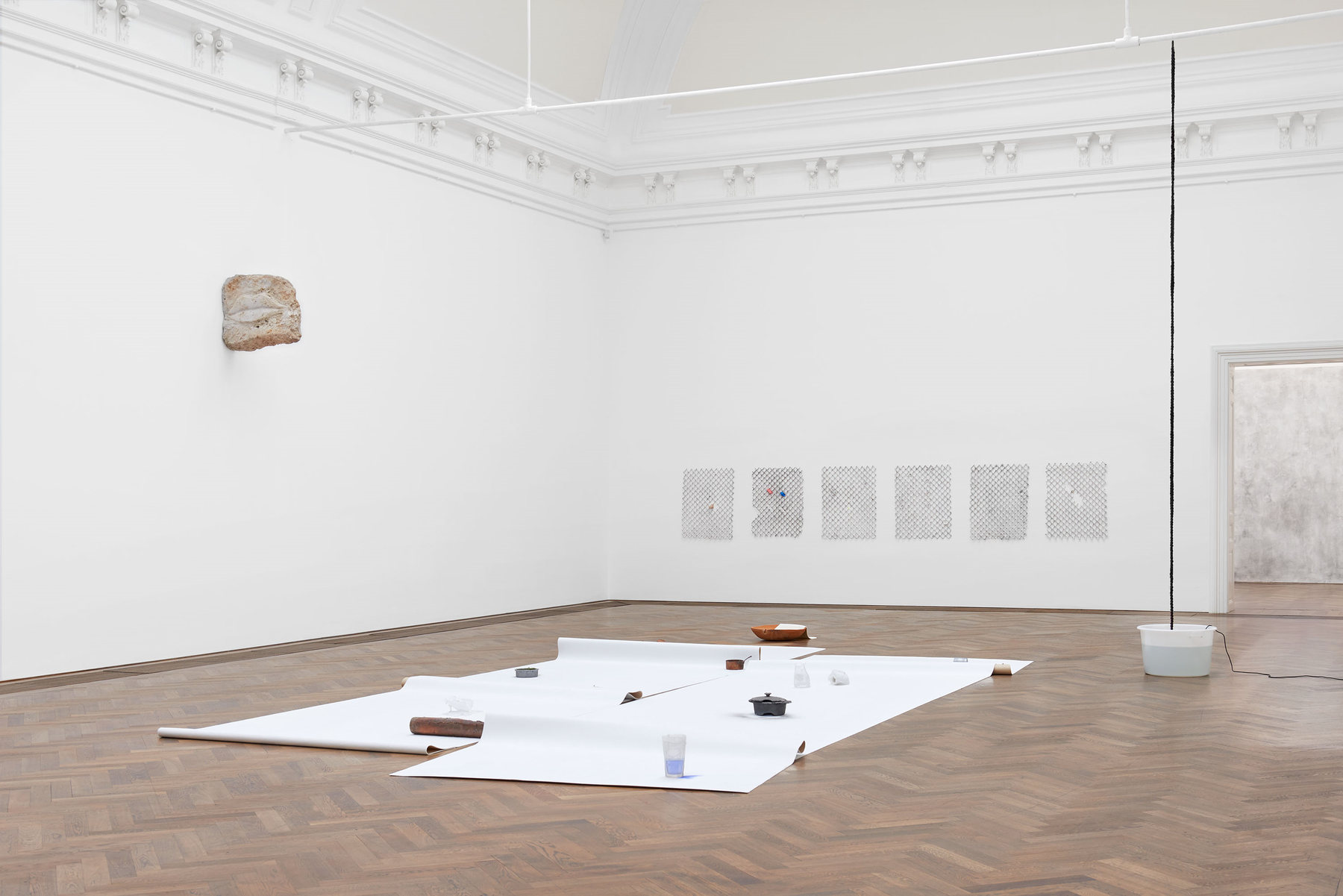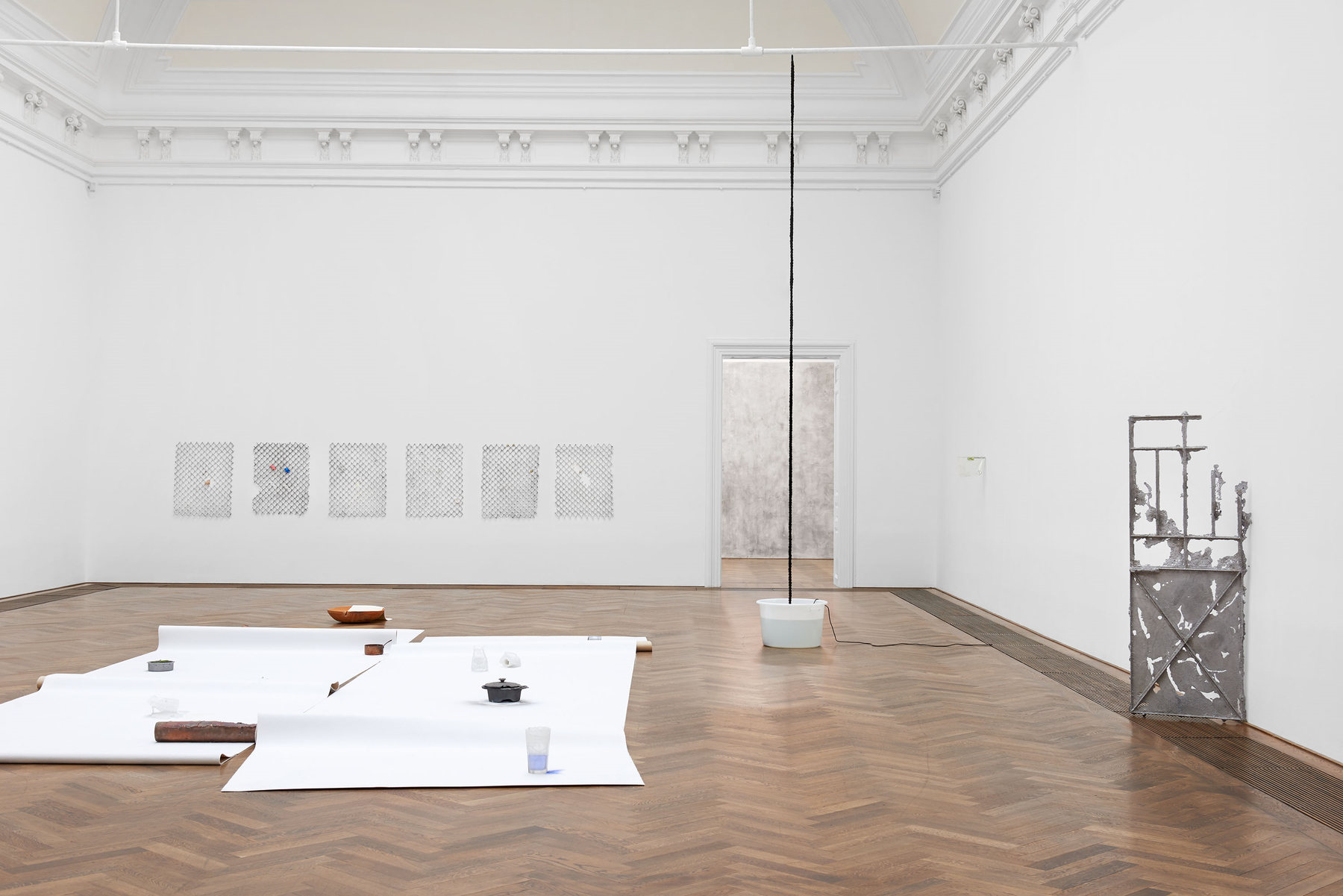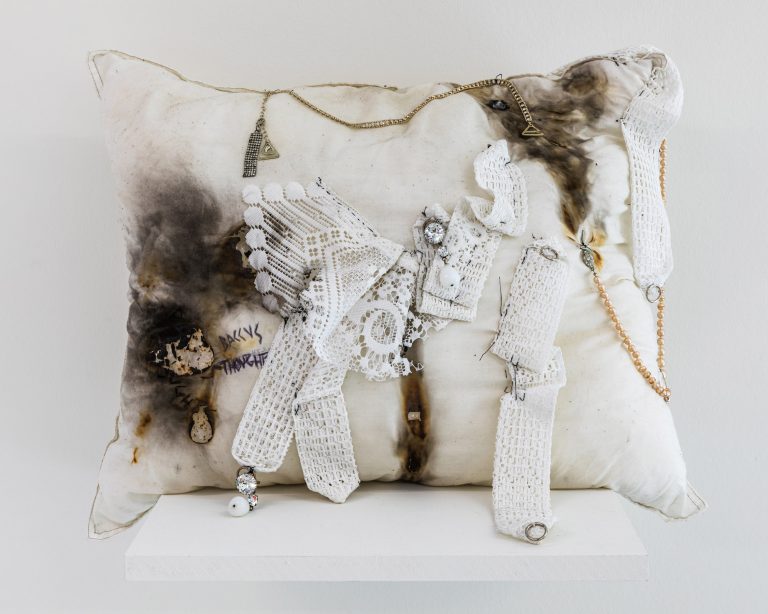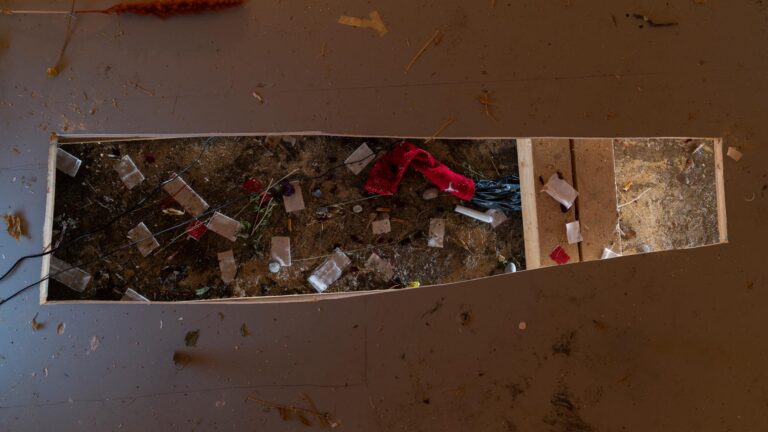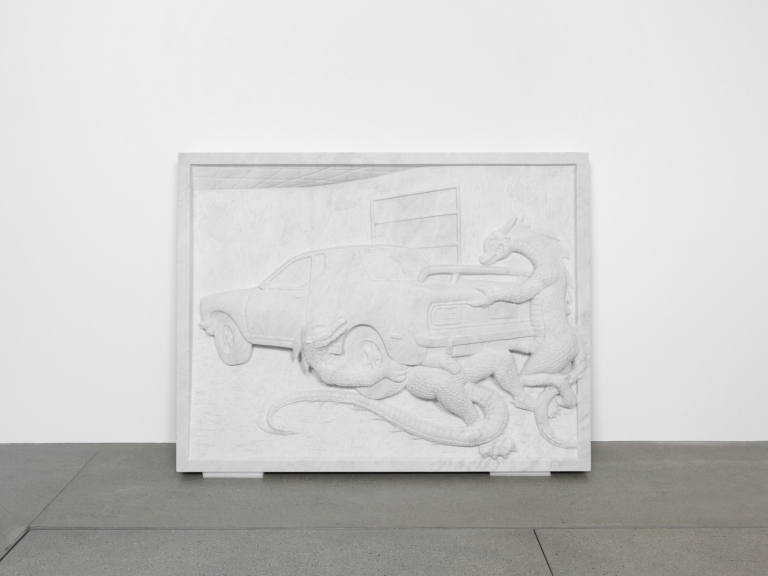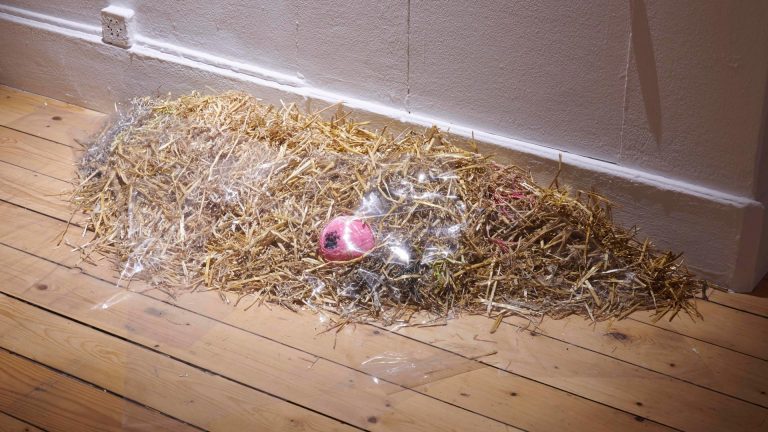Artist: Tania Pérez Córdova
Exhibition title: Daylength of a room
Venue: Kunsthalle Basel, Basel, Switzerland
Date: October 26, 2018 – January 6, 2019
Photography: all images copyright and courtesy of the artist and ©Kunsthalle Basel
Imagine an ice cube, melted down, then poured back into the ice tray and refrozen. It finds itself a tiny bit smaller, containing a little less of itself, when remade into its own shape. Now imagine this process applied to other objects in the world, as Tania Pérez Córdova does. She makes a mold of a thing, melts it down, and then casts it as a copy made from the molten material of the thing itself. This curious procedure is central to the Mexi-can artist’s first institutional solo exhibition in Europe.
In preparation for the show, Córdova collected an array of prosaic things—including a copper sauce-pan, a glass pitcher, a metal chain -link fence, silver cutlery—some her own, some found, and subjected them to her copy-of-the-thing-made-from-the-thing-itself process. Hung on a wall or over a door or placed on carpet in the center of a room, her un-deniably ungainly results are rough, pock-marked, and somehow incomplete even though the visitor’s eye can easily identify their initial forms. They are built up from accretions of their original matter, with occasional material gaps, made obvious by the stains of lipstick or herbal protein powder—carefully chosen stuff that has seemingly seeped out of her various once-functioning receptacles.
In another work, Paisaje (landscape), a bar of soap or a bottle cap is now wedged in a replica fence’s new gaps, making these even more obvious, pointed. For all her objects’ insistent materiality, what we are truly seeing, you might say, is the lacuna between original and copy, between first generation and second, between mass-produced readymade and handmade replica. Córdova has literally made loss and put it on display.
The artist relishes this process of making—or perhaps better put, unmaking. “In theory,” she suggests, “if I would continue the cycle indefinitely, at some point it will result in the things’ disappearance.” For instance, that ice cube would completely dissipate in the process of trying to (re)become itself. In the exhibition, the artist doesn’t go so far as to make her objects disappear, but in a material as much as a metaphorical sense, they arguably negotiate loss and regeneration, authenticity and imitation.
The mutation or deceptiveness of a thing—how its material integrity shifts, how it can cos-metically enhance something (or someone), or simply pretend to be something it’s not—man-ifests in various guises in Córdova’s elegantly gnomic show. A piece of obsidian (molten volcanic sludge cooled to become glasslike) with a polished depression holds a cheap, imitation-gold chain (Sincere / Non-sincere). The luxurious-looking natural stone surface jars with the cheapness of a chain that is masquerading as something it isn’t. Nearby, more than nine meters of the same sort of necklaces purchased by the artist at a Mexico City market are strung together and suspended from a high metal bar (People keeping their belongings, others throwing theirs away).
All but one were bought at the price of costume jewelry; a single chain among them was promised to be real gold, and sold to the artist as such, although it looks exactly like the others. Visitors will be unable to distinguish them, but neither can the artist, who supposes she’ll have to place her faith in the seller’s version of the truth.
A shelf-like artwork (OOOOO) made of variegated thin slabs of broken marble and plaster lines the wall (notice, again, how fine materials meet their economically inferior stand-ins). Circular recesses carved into them hold colored contact lenses, products par excellence of aspirational cosmetic transfor-mation. Exhibition visitors will encounter enlisted staff members who have temporarily transformed the color of one eye with the other half of the contact lens pair, activating the work and extending it beyond the exhibition space proper. Sculpture, Córdova insists, can be at once material and perfor-mative and a negotiation.
“Above all,” a critic of her work once wrote, “Córdova is concerned with time.” This exhibition exemplifies that concern, with its title’s use of “daylength” suggesting as much. The English term is borrowed from science, proposing that the notion of a single “day” (24 hours for humans, perhaps only 6 hours for a certain plant) might be measured according to different rules, depending on who—or what—you are talking about. For her exhibition, the artist creates works that negoti-ate different temporalities. They remind us that although the artwork is typically thought of as something forever-fixed once completed, hers might just operate according to another rhythm.
While conceiving the show, Córdova was struck by a story she heard: that in the Ramesside period in ancient Egypt, existing Sphinx statues were recycled by newly arrived pharaohs, who would slightly alter their facial features to conform to new tastes and changing political ideology. Inspired by this, she created a new sculpture in relief of a mouth (Woman next to a still-life), carved from pumice and hung high on a wall, like a clock in a train station. Its existence in its current form will last as long as the Kunsthalle Basel exhibition is on view. Upon each subsequent showing, she will alter the shape of the mouth, adding teeth or a grin in its next incarnations. Continuously evolving, it defies being fixed as it marks passing time.
Along another wall are three sets of pumice sculptures (3 figures thinking; two standing, one seated ), each forming the two halves of a vaguely shaped head (think Constantin Brâncuși’s 1910 Sleeping Muse). Each one sand-wiches specially made flat loaves of bread, baked so thoroughly that they are hardened, petrified. Yet another loaf, presented in a back room, has cigarettes baked into it so that the heat of the oven literally “smoked” the cigarettes while encrusting them into the loaf (Strike). These add to the wildly ecclectic materi-al universe that populates the artist’s exhibition.
In the piece poetically called Architect holding a building, Córdova’s use of volcanic ash (mixed with gunpowder and cosmetics) to paint walls reminds us that there are active volcanos not far from her hometown, acting as an ever-ready threat, a ticking time bomb. Time is manifest in yet another register in her placement of a plant with so-called shot hole disease at the entrance to her exhibition. Plants with this fungal disease, as the name suggests, have what look like bullet holes in their leaves, and without treatment will slowly, entirely disintegrate. Like the objects in the exhibition that hint at their own dissolution, time here acts as a sculptural agent.
In a moment when no one seems to have time for anything, Tania Pérez Córdova won’t let us forget the time things take: for lava to turn to glassy stone, for a cigarette to burn, for a loaf to bake, for hair to grow impossibly long, for cheap metal to reveal itself as imitation gold thanks to humidity and oxidation. These different temporalities enrich the daylength of this room.
Tania Pérez Córdova, installation view, Daylength of a room, Kunsthalle Basel, 2018. Photo: Philipp Hänger / Kunsthalle Basel
Tania Pérez Córdova, installation view, Daylength of a room, view on, Woman next to a still-life, 2018, Kunsthalle Basel, 2018. Photo: Philipp Hänger / Kunsthalle Basel
Tania Pérez Córdova, installation view, Daylength of a room, view on, 3 figures thinking; two standing, one seated, 2018, Kunsthalle Basel, 2018. Photo: Philipp Hänger / Kunsthalle Basel
Tania Pérez Córdova, installation view, Daylength of a room, view on, Sincere / Non-sincere, 2018, Kunsthalle Basel, 2018. Photo: Philipp Hänger / Kunsthalle Basel
Tania Pérez Córdova, installation view, Daylength of a room, Kunsthalle Basel, 2018. Photo: Philipp Hänger / Kunsthalle Basel
Tania Pérez Córdova, installation view, Daylength of a room, view on, Figure standing next to a fountain, 2018, Kunsthalle Basel, 2018. Photo: Philipp Hänger / Kunsthalle Basel
Tania Pérez Córdova, installation view, Daylength of a room, Kunsthalle Basel, 2018. Photo: Philipp Hänger / Kunsthalle Basel
Tania Pérez Córdova, installation view, Daylength of a room, view on Stuttering, 2018 (detail), Kunsthalle Basel, 2018. Photo: Philipp Hänger / Kunsthalle Basel
Tania Pérez Córdova, installation view, Daylength of a room, Kunsthalle Basel, 2018. Photo: Philipp Hänger / Kunsthalle Basel
Tania Pérez Córdova, installation view, Daylength of a room, Kunsthalle Basel, 2018. Photo: Philipp Hänger / Kunsthalle Basel
Tania Pérez Córdova, installation view, Daylength of a room, view on, Strike, 2018, Kunsthalle Basel, 2018. Photo: Philipp Hänger / Kunsthalle Basel
Tania Pérez Córdova, installation view, Daylength of a room, Kunsthalle Basel, 2018. Photo: Philipp Hänger / Kunsthalle Basel


